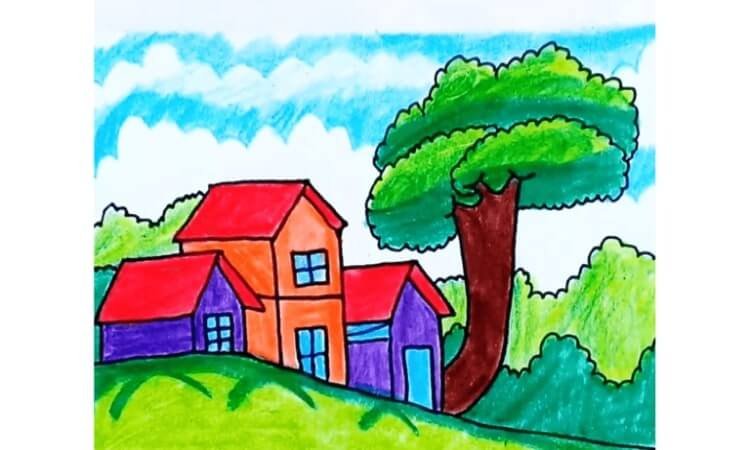How To Draw a Landscape For Kids Because autumn is in the air, now is the ideal time to try out some new painting methods you’ve been meaning to try. How To Draw a Landscape For Kids made ourselves at home at the kitchen table, where we worked on some artwork to put out for the autumn season.
My younger child enjoyed scrape painting because it let him to use bright and vivid colours, and he found it fun to convert a blank sheet of paper into a vibrant autumn landscape complete with falling leaves.
The following elements contributed to our Autumn landscape:
- Tape for white art paper (transparent or painter’s tape would work well in this case).
- Credit card or a card made of strong plastic, with a variety of paint colours
- Rubber bands made with Q-Tips
Crafting an Autumn Landscape Art Activity in the Art World
- To begin, you need to be aware that to complete our painting of a fallen tree, we utilised a total of three distinct painting techniques. Three is correct!
- I realise that this may seem like an intimidating task for a preschooler or a young child, but I was so impressed by how well my four-year-old son performed with it.
- I believe that the fact that each painting style is still founded in the “process art” philosophy is the key to success.
- There is still a lot of potential for experimenting, which means there will be plenty of opportunities for fun for your young one.
- Tape resist, scrape paint, and pointillism with Q-Tips were the techniques we utilised for this project.
- These methods involve fine motor abilities, all of which are completely within the capability level of young toddlers.
- This craft for the fall season is a lot simpler to do than it looks!
Beginning with the Tape Resist
- My son began by adhering lines of tape to the top of his paper to approximately the middle. These would eventually become our white tree trunks, so estimate your paper of where you would like the tree trunks to be placed.
- Leave space between the tape and the top of your paper. This will make it much simpler and less damaging to the artwork to remove the tape later.
- Scotch tape was what we used, but you could also try other types of tape, such as painter’s tape, masking tape, packing tape, or even duct tape!
Prepare to Remove the Paint From the Walls
- We applied two distinct layers of scrape paint.
- Using a squeeze bottle, my youngster started making dots on his paper’s lower half with orange, brown, and yellow paint.
- After that, he used the plastic card to scrape through the specks of paint to reveal the colour behind it.
- The combination of colours created an effect almost identical to a forest floor covered with autumn leaves.
- After applying the warm colours at the bottom of the paper, the cool blues and whites were spread throughout the upper half of the sheet.
- He mixed all of these hues to create a clear and brilliant blue sky for autumn!
- Pointillism is used to create leaves.
- The final phase in creating the autumn environment was adding falling leaves.
This was such an easy step
- On a plate, I dabbed some orange and yellow paint here and there. Afterwards, I used a few Q-tips to make a bundle that I secured with a rubber band.
- My little one moved his Q-Tips back and forth between his hands.
- First, he moistened his “paintbrush” by dabbing it in each hue. The next step was embellishing the painting with vibrant clusters of autumn foliage.
- We couldn’t have been happier with how our autumn landscape art turned out!
- I like how the colours play off each other and bring to mind some of our favourite trees in the fall.
- My preschooler had a great time experimenting with the different painting styles.
- Scrape painting was, without a doubt, his top pick for the newest technique. We will make it a point to give this another shot very soon!



